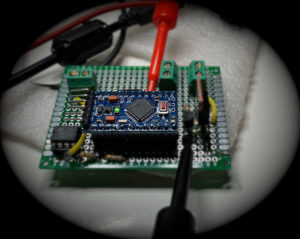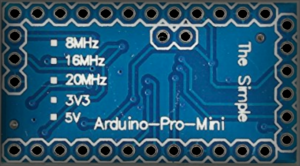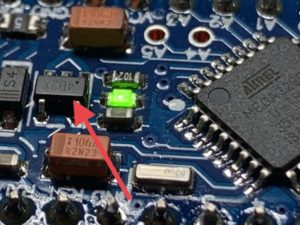Yesterday I was working with a Chinese clone of Arduino Pro Mini, which I bought for less than 10€ at Amazon.
I needed to build a very low consumption device and after reading this article I found the Pro Mini to be perfectly suited for the purpose.

The clone is one of those labeled with “The Simple” in the back of the PCB, as shown here:

For my project I had to use 12V DC input so I fed it by the RAW pin, as described in the Arduino Pro Mini documentation.
I programmed it trough an Arduino Uno, everything went good so I decided to put it into the final circuit.
Long story short, it fried immediately after supplying 12V.
I was surprised by such a behavior so I checked back in the documentation a few times, but everything looked correct, it had to work. I looked at the PCB schematics in the Pro Mini documentation and found the regulator to be the
I looked at my board and found out the regulator was not a MIC5205, but a “I searched the web and found this discussion on the Arduino Pro Mini Chinese clones and their voltages, in which some regulator labels are listed, including KB33, S20K, F34V, L0RA, L0RB for the 3.3V variant. 4B2X was not showing up, so I started to suspect either a defective component or an out-of-specs regulator.
I then decided to test another new Arduino Pro Mini board that came with the same “4B2X” regulator as the fried one, and started supplying 5V to the RAW pin, increasing the voltage at small steps, to find wether or not it was capable of working with a 12V supply voltage (as stated in the Arduino Pro Mini documentation).
The regulator output stayed at 3.3V until up to about 11.5 V input, then a single increase of 0.2V made the output “run away”, all the way up to the input voltage, frying the microcontroller. The exact same input/output behavior was delivered by the regulator of the first failed board.
Looks like the 4B2X regulator is not suited for 12V, its maximum input voltage being just about 11.5V, well below the MIC5205’s 16V maximum, which is needed in car/boat/camper environments that use Pb 12V batteries, where voltages typically grow up to 13.8 – 14.4V when the engine is on.
In conclusion, if you bought an Arduino Pro Mini clone that comes with that regulator and you need to supply a 12V DC voltage, consider adding a zener diode (5V at least) to drop the voltage down to safe values. Even better, if you have a spare MIC5205 or a real equivalent just solder it in place of the 4B2X.
Hopefully this will avoid someone frying his new Arduino Pro Mini just like it happened to me.
73 de IU3JSX

Hi Marco
Just found your page while trying to identify the 4B2X regulator on my WemosD1.
My goal was different as I’m looking for LDO with the smallest drop-out in order to maximize LiIon battery usage.
Regarding your project embedded in a car, I would unadvise to use a linear regulator to drop from 12-14V down to 3V3 for 2 reasons:
1) Linear regulator “waste” the voltage difference as heat. Roughly if trying to get 150mA from a 12V battery you would have to dissipate 1.3W. All this energy will be wasted.
2) The package of the chip is limited in its dissipation capacity (455mW in the case of the MIC5205) which means that you cannot get more than 52mA. As the chip itself requires 2.5mA to work. You barely gets 50mA max. See section 4.6 of the datasheet.
May be that’s enough and you don’t have to power much other components around the ATMEGA itself but don’t forget this.
This is why when working with “high voltage” inputs, I will always use a DC/DC step down converter. These can get easily 80% or more efficiency which means that a circuit that need 100mA at 3.3V (= 330mW) will use only 35mA on the 12V battery (vs 100mA with linear regulator).
If your ATMEGA is going to sleep in low power mode, you may need to look also at the current which the regulator will use even when load current is 0. In the case of the MIC5205, look at the ground-pin current when ILoad = 100µA => 125µA which is not bad indeed for a car battery powered device.
For my LiIon battery powered project I am replacing the WemosD1 regulator with a HT7330 regulator (3.0V output, just above 2.9V the limit for the ESP8266) which as a drop-out of 90mV and a quiescent current of less than 7µA. So all in total when my ESP8266 is asleep, the circuit do not draw more than ~15µA from the battery. And I can use the battery from 4.2V down to 3.0V which maximise the battery lifetime.
Happy to get your feedback
(And happy new year by the way)
Hi Barbudor,
thanks for your feedback! And sorry for my late reply.
In my case I used a 6V zener in series since my requirement was to drive a very low current implementation that most of the time stays in stand by (in which the current draw is less than 1 mA).
It’s a bilge pump controller for my boat, which every 2s wakes up and senses the water level. If above threshold, powers up a power MOSFET. Even in the ON state it only draws 4.7 mA.
Had it been an even slightly more current hungry application, I would have certainly used a step down regulator as you correctly suggested, but in my particular case it was not needed.
Thanks again for visiting!
Dear Marco, thanks a lot. I was just trying to figure out what to do. Your post saved my day. I will feed 5-9 Volts to RAW pin.
Hi Dr. Phool Singh Chauhan,
I’m glad it helped.
Best wishes for your project!
I identified the mysterious 4B2X LDO to be a Torex XC6204B33 LDO:
https://www.torexsemi.com/file/xc6205/XC6204-XC6205.pdf
Its Vin voltage is indeed specified @ 10V max, unlike the MIC5205 @ 16V!
Hi Squonk42,
Thank you very much for your follow up!
Page 44/48 shows the marking rule an 4B2X is one of the XC6204B series.
Could you share the name/type of programmer you used, in your project?
(background:- I ended up here while looking for a programmer module for my 3.3V Pro Mini. It seems that I have got myself a Pro Mini same as one mentioned here. Originally, I had purchased a CP2102 module to program it. But for some reason it died (last time I checked, Pro Mini works fine) Now I need one to program, but can’t find one compatible
THanks in advance)
Hello Sandeep V Menon,
in my case I used an Arduino UNO board to program the pro mini. If I remember correctly the instruction I followed are here: https://www.instructables.com/How-to-Program-Arduino-Pro-Mini-Using-Arduino-UNO/
I hope this helps.
Kind regards,
Marco
Just got an ESP32 dev board with one of these LDO voltage regulators. Funny thing is that the ESP32 uses >150ma when on wifi, so when that happens, the board resets do to brownout condition. LOL. The board can’t even power itself. Gonna have to replace the LDO with a higher current version. found your page by searching for the chip marking. Thanks!
Hi Ed, thanks for reporting and for having taken your time to write a comment here!
Arduino uno clones also have 4b2x ( instead of MIC5205 ) but it is supplied by constant 5v from a ldo linear voltage regulator.
Thanks, I was only attempting to decide what to do. Your article made my day. I’ll supply 5 to 9 volts to the RAW pin.
Hi Anne, thanks for your comment!